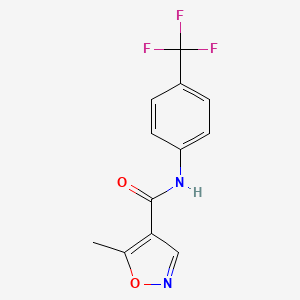Drug Information
Drug (ID: DG00551) and It's Reported Resistant Information
| Name |
Leflunomide
|
||||
|---|---|---|---|---|---|
| Synonyms |
Leflunomide; 75706-12-6; Arava; lefunamide; Leflunomida; Leflunomidum; 5-methyl-N-[4-(trifluoromethyl)phenyl]-1,2-oxazole-4-carboxamide; HWA 486; Leflunomidum [INN-Latin]; HWA-486; Repso; SU101; Arava (TN); 5-methyl-N-(4-(trifluoromethyl)phenyl)isoxazole-4-carboxamide; 5-Methyl-N-(4-(trifluoromethyl)phenyl)-4-isoxazolecarboxamide; 5-Methylisoxazole-4-carboxylic acid (4-trifluoromethyl)anilide; 4-Isoxazolecarboxamide, 5-methyl-N-[4-(trifluoromethyl)phenyl]-; alpha,alpha,alpha-Trifluoro-5-methyl-4-isoxazolecarboxy-p-toluidide; UNII-G162GK9U4W; SU-101; 5-methyl-N-[4-(trifluoromethyl)phenyl]isoxazole-4-carboxamide; RS-34821; CHEMBL960; MLS000069648; CHEBI:6402; G162GK9U4W; 5-Methylisoxazole-4-(4-trifluoromethylcarboxanilide); MFCD00867593; NSC-677411; NSC-759864; NCGC00015610-02; SMR000058209; 5-methyl-N-[4-(trifluoromethyl)phenyl]-4-isoxazolecarboxamide; 4-Isoxazolecarboxamide, 5-methyl-N-(4-(trifluoromethyl)phenyl)-; CAS-75706-12-6; leflunomide medac; DSSTox_CID_3201; DSSTox_RID_76923; DSSTox_GSID_23201; Leflunomida [INN-Spanish]; SU 101 (pharmaceutical); Lefunomide [Inn-Spanish]; HSDB 7289; SR-01000000191; Arabloc; HWA486; Leflunomide teva; N-(4'-Trifluoromethylphenyl)-5-methylisoxazole-4-carboxamide; L04AA13; Prestwick_87; Leflunomide [USAN:USP:INN:BAN]; Leflunomide winthrop; SU 101; SULOL; Leflunomide ratiopharm; Spectrum_000322; Opera_ID_1709; Prestwick0_000772; Prestwick1_000772; Prestwick2_000772; Prestwick3_000772; Spectrum5_000850; Lopac-L-5025; L 5025; SCHEMBL5057; BIDD:PXR0189; Lopac0_000649; BSPBio_000844; KBioSS_000802; Leflunomide, Immunosuppressant; MLS001076267; DivK1c_000916; Leflunomide (JAN/USP/INN); SPECTRUM1503927; 5-Methylisoxazole-4-(4-trifluoromethyl)carboxanilide; SPBio_002783; BPBio1_000930; GTPL6825; ZINC4840; DTXSID9023201; HMS502N18; KBio1_000916; KBio2_000802; KBio2_003370; KBio2_005938; AOB5964; NINDS_000916; 4-Isoxazolecarboxamide, 5-methyl-N-(4-(trifluoromethyl)phenyl; HMS1570K06; HMS1922M06; HMS2090O12; HMS2097K06; HMS2235C07; HMS3262A19; HMS3268D12; HMS3371F21; HMS3414P03; HMS3654F07; HMS3673M17; HMS3678N21; HMS3714K06; HMS3865I13; Pharmakon1600-01503927; ALBB-019233; BCP22241; HY-B0083; Tox21_110182; Tox21_301873; Tox21_500649; BDBM50054601; DL-433; NSC677411; NSC759864; s1247; STL426823; AKOS000265193; Tox21_110182_1; AC-6796; BCP9000846; CCG-204736; CS-1781; DB01097; KS-1076; LP00649; MCULE-9490869974; NSC 677411; NSC 759864; SB17287; SDCCGSBI-0050629.P003; IDI1_000916; NCGC00015610-01; NCGC00015610-03; NCGC00015610-04; NCGC00015610-05; NCGC00015610-06; NCGC00015610-07; NCGC00015610-08; NCGC00015610-09; NCGC00015610-10; NCGC00015610-11; NCGC00015610-12; NCGC00015610-13; NCGC00015610-14; NCGC00015610-17; NCGC00015610-18; NCGC00015610-30; NCGC00022625-03; NCGC00022625-04; NCGC00022625-05; NCGC00022625-06; NCGC00022625-07; NCGC00022625-08; NCGC00255370-01; NCGC00261334-01; BM164612; H527; Leflunomide 100 microg/mL in Acetonitrile; A9622; AB00052389; EU-0100649; FT-0621959; L0250; SW196399-3; C07905; D00749; MLS-0003109.0001; AB00052389-17; AB00052389-18; AB00052389_19; AB00052389_21; 706L126; Q248550; Q-201289; SR-01000000191-2; SR-01000000191-4; SR-01000000191-7; BRD-K78692225-001-03-9; BRD-K78692225-001-11-2; 5-methyl-4-(4-trifluoromethyl-phenyl)aminocarbonylisoxazole; 5-methyl-4-(4-trifluoromethylphenyl)aminocarbonylisoxazole; Leflunomide, European Pharmacopoeia (EP) Reference Standard; N-(4-trifluoromethylphenyl)-5-methylisoxazole-4-carboxamide; 5-Methyl-N-[4-(trifluoromethyl)-phenyl]isoxazole-4-carboxamide; 5-methylisoxazole-4-carboxylic acid (4-trifluoromethyl)-anilide; N-(4-trifluoromethylphenyl)-5-methylisoxa-zole-4-carboxamide; Isoxazole-4-carboxamide, 5-methyl-N-[4-(trifluoromethyl)phenyl]-; Leflunomide, United States Pharmacopeia (USP) Reference Standard; 5-methyl-N-(4-(trifluoromethyl)phenyl)isoxazole-4-carboxamide;Leflunomide; HWA486; RS-34821; SU101;HWA 486; RS 34821; SU 101; Leflunomide, Pharmaceutical Secondary Standard; Certified Reference Material; Leflunomide for peak identification, European Pharmacopoeia (EP) Reference Standard
Click to Show/Hide
|
||||
| Indication |
In total 2 Indication(s)
|
||||
| Structure |

|
||||
| Drug Resistance Disease(s) |
Disease(s) with Clinically Reported Resistance for This Drug
(1 diseases)
[1]
|
||||
| Target | Plasmodium Dihydroorotate dehydrogenase (Malaria DHOdehase) | PYRD_PLAF7 | [1] | ||
| Click to Show/Hide the Molecular Information and External Link(s) of This Drug | |||||
| Formula |
C12H9F3N2O2
|
||||
| IsoSMILES |
CC1=C(C=NO1)C(=O)NC2=CC=C(C=C2)C(F)(F)F
|
||||
| InChI |
1S/C12H9F3N2O2/c1-7-10(6-16-19-7)11(18)17-9-4-2-8(3-5-9)12(13,14)15/h2-6H,1H3,(H,17,18)
|
||||
| InChIKey |
VHOGYURTWQBHIL-UHFFFAOYSA-N
|
||||
| PubChem CID | |||||
| ChEBI ID | |||||
| TTD Drug ID | |||||
| VARIDT ID | |||||
| INTEDE ID | |||||
| DrugBank ID | |||||
Type(s) of Resistant Mechanism of This Drug
Drug Resistance Data Categorized by Their Corresponding Diseases
ICD-15: Musculoskeletal/connective-tissue diseases
| Drug Resistance Data Categorized by Their Corresponding Mechanisms | ||||
|
|
||||
| Key Molecule: ATP-binding cassette sub-family G2 (ABCG2) | [1] | |||
| Molecule Alteration | Expression | Up-regulation |
||
| Resistant Disease | Rheumatoid arthritis [ICD-11: FA20.0] | |||
| Experimental Note | Identified from the Human Clinical Data | |||
| Mechanism Description | MTX is a substrate for eight ABC transporters. In vitro studies demonstrated that RAFLS treated with MTX had higher ABCB1 expression levels than controls, with a positive correlation between ABCB1 expression levels and RA treatment duration. In addition to MTX, other DMARDs (e.g. sulfasalazine, leflunomide, bucillamine, azathioprine), glucocorticoids (e.g. betamethasone, dexamethasone), and NSAIDs (e.g. celecoxib and indomethacin) are also substrates of ABC transporters. | |||
|
|
||||
| Key Molecule: Cellular tumor antigen p53 (TP53) | [1] | |||
| Molecule Alteration | Mutation | p.P151S+p.R175H+p.G245C+p.R282W |
||
| Resistant Disease | Rheumatoid arthritis [ICD-11: FA20.0] | |||
| Experimental Note | Identified from the Human Clinical Data | |||
| Mechanism Description | The wild-type p53 tumor suppressor (p53) is overexpressed in response to DNA damage and inflammation in RA fibroblast-like synoviocytes (FLS), which are highly specialized mesenchymal cells located in the internal lining of the synovium and are involved in the pathogenesis and progression of RA. In line with the effects of p53 gain-of-function mutation in tumor progression, mutation-mediated gain-of-function of p53 may contribute to the invasiveness and apoptosis-resistant feature of FLS in RA and the increased expression of cartilage degradative proteases, leading to degeneration of cartilage and bone. Gene knockout or gene transfer studies using a collagen-II-induced arthritis (CIA) model have established the crucial role of p53 in RA that provides a basis for additional research to fully characterize the clinical implications of p53 somatic mutations in drug-resistant RA. | |||
References
If you find any error in data or bug in web service, please kindly report it to Dr. Sun and Dr. Zhang.
